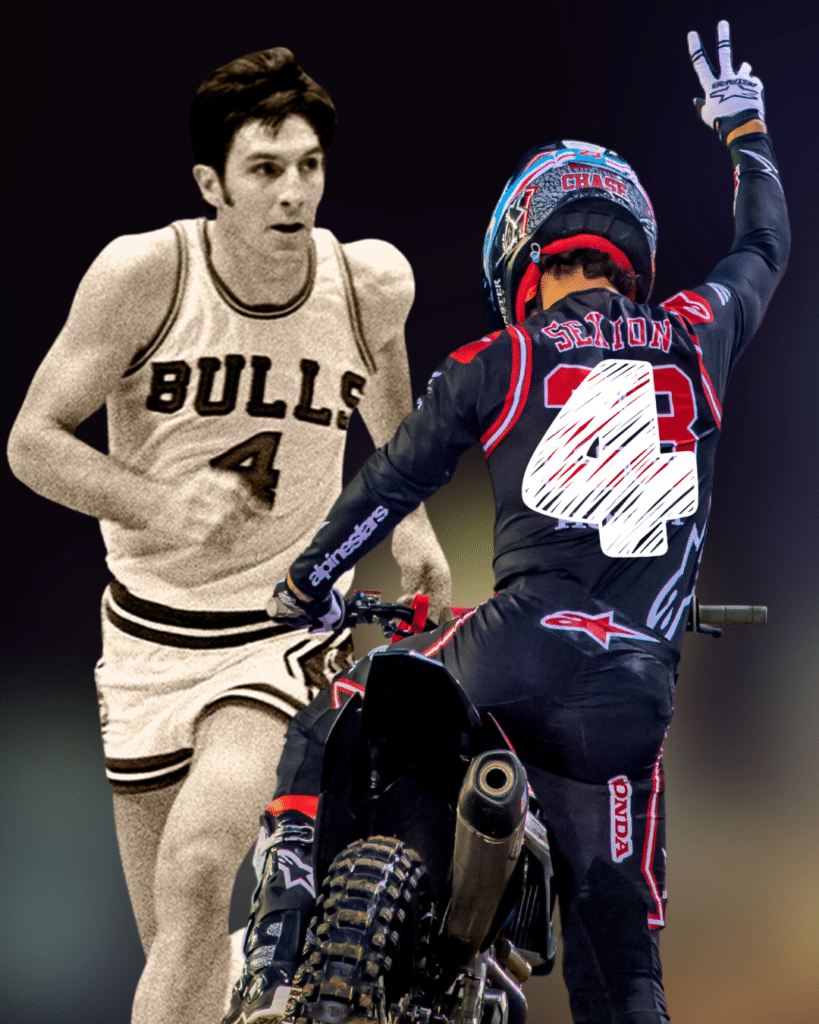Fourplay: The Analytics of Number Four in Motocross
By
The 2024 Supercross and Motocross Professional Numbers have been announced and Chase Sexton has officially chosen to swap the symbol of one GOAT for another. After five seasons with number 23, Sexton will build a new numerical identity around the number four.
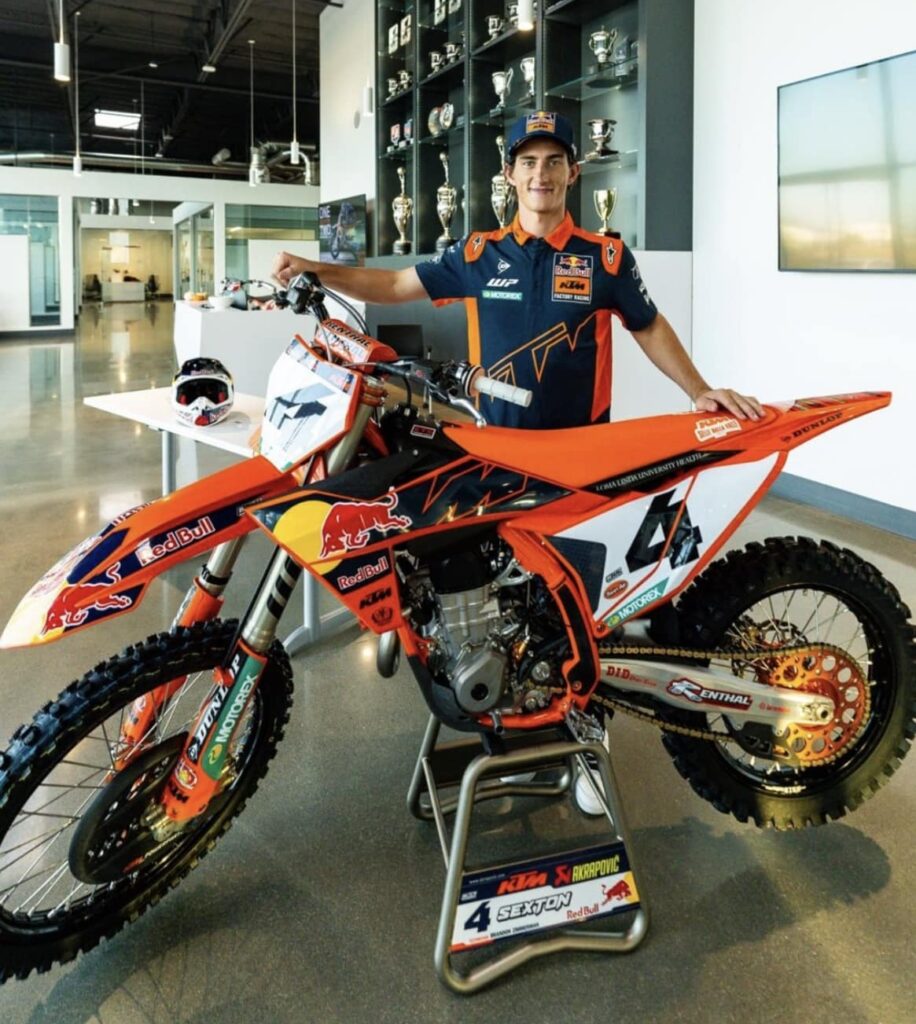
Snapshot of #4 in AMA SX/MX History
1973
FIRST YEAR IN USE
2020
LAST YEAR IN USE
24
RIDERS WHO WORE #4
42
YEARS IN USE
Considering how hard and how long he leaned into the Chicago Bulls/Michael Jordan theme with 23, it’s a surprising branding and marketing shift. This is, however, the first opportunity he’s had to select a single digit, an option that opened for him after winning the 2023 Monster Energy Supercross Championship.
In motocross, number four has a heavy aura and comes with unavoidable expectation because, outside of number one, it has taken more checkered flags than any other number in the sport’s history.
BENCH RACING
What do you think of Chase Sexton changing his career number from 23 to 4?
Riders Who Wore #4
*Ranked by # of races started WHILE running #4. Stats listed were earned WHILE running #4. Scroll to the bottom if you want an even more complete history of the number 4
| RIDER NAME | CHAMPS | STARTS | PTS | PTS / START | W | POD | MOTO W | MOTO POD |
|---|---|---|---|---|---|---|---|---|
| Ricky Carmichael | 12 | 191 | 6,416 | 34 | 124 | 171 | 140 | 166 |
| Blake Baggett | 0 | 171 | 3,546 | 21 | 7 | 35 | 9 | 40 |
| Ron Lechien | 0 | 46 | 1,199 | 26 | 4 | 27 | 6 | 23 |
| Steve Lamson | 0 | 43 | 844 | 20 | 2 | 27 | 3 | 16 |
| Kent Howerton | 1 | 39 | 927 | 24 | 9 | 15 | 10 | 19 |
| Johnny O'Mara | 1 | 34 | 884 | 26 | 2 | 20 | 4 | 20 |
| Mike Kiedrowski | 1 | 31 | 791 | 26 | 3 | 12 | 10 | 17 |
| Guy Cooper | 1 | 31 | 731 | 24 | 5 | 8 | 10 | 17 |
| Broc Glover | 1 | 30 | 815 | 27 | 6 | 17 | 9 | 18 |
| Larry Ward | 0 | 28 | 570 | 20 | 1 | 5 | 1 | 5 |
| Ezra Lusk | 0 | 28 | 620 | 22 | 6 | 12 | 3 | 7 |
| Jeff Ward | 1 | 27 | 767 | 28 | 12 | 20 | 13 | 20 |
| Damon Bradshaw | 0 | 20 | 495 | 25 | 11 | 13 | 5 | 6 |
| Steve Wise | 0 | 19 | 357 | 19 | 1 | 6 | 5 | |
| Doug Henry | 0 | 17 | 328 | 19 | 2 | 6 | 1 | 4 |
| John DeSoto | 0 | 15 | 705 | 47 | 1 | 5 | 2 | 14 |
| Danny Laporte | 0 | 14 | 301 | 22 | 1 | 2 | 3 | 5 |
| Bob Hannah | 0 | 13 | 329 | 25 | 1 | 3 | 1 | 6 |
| Jim Weinert | 1 | 11 | 345 | 31 | 4 | 7 | 6 | 10 |
| Steve Stackable | 0 | 9 | 648 | 72 | 4 | 3 | 5 | |
| Rick Burgett | 0 | 9 | 82 | 9 | 1 | |||
| Chuck Sun | 0 | 9 | 98 | 11 | 1 | |||
| Tommy Croft | 0 | 4 | 85 | 21 | 1 | |||
| Gary Jones | 0 | 3 | 39 | 13 | ||||
| Grand Total | 19 | 842 | 21,922 | 26 | 202 | 402 | 239 | 424 |
That’s because in 2001, Ricky Carmichael made a then-unprecedented decision not to run a number one plate on his Kawasaki KX250 in defense of his Pro Motocross Championship. He put four atop the podium 124 times in eight years and won 12 championships with it. That’s more than the combined wins of all the riders in AMA pro racing history to have used the number, going back to 1973.
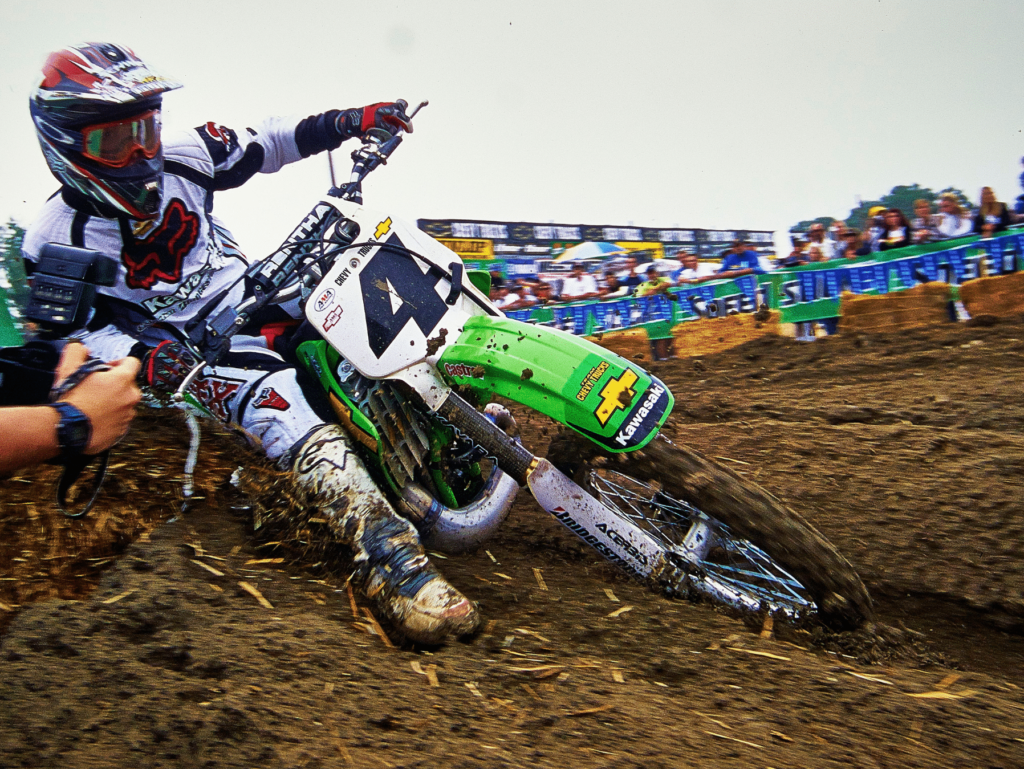
Four became so synonymous with winning that it set an impossible benchmark for any future rider who dares apply those decals. It’s almost like you have to win with it.
Carmichael retired in 2007, specifically on the day Sexton celebrated his eighth birthday, but he’s still very active in the sport and his identity is closely aligned and associated with number four.
Now an ambassador for Triumph Motorcycles, Carmichael debuted the TF250X during intermission at the SuperMotocross World Championship finals in Los Angeles, coincidentally, on September 23, 16 years to the day after his last professional race. The Triumph had his copyrighted and trademarked four typography in white on the black number plates.
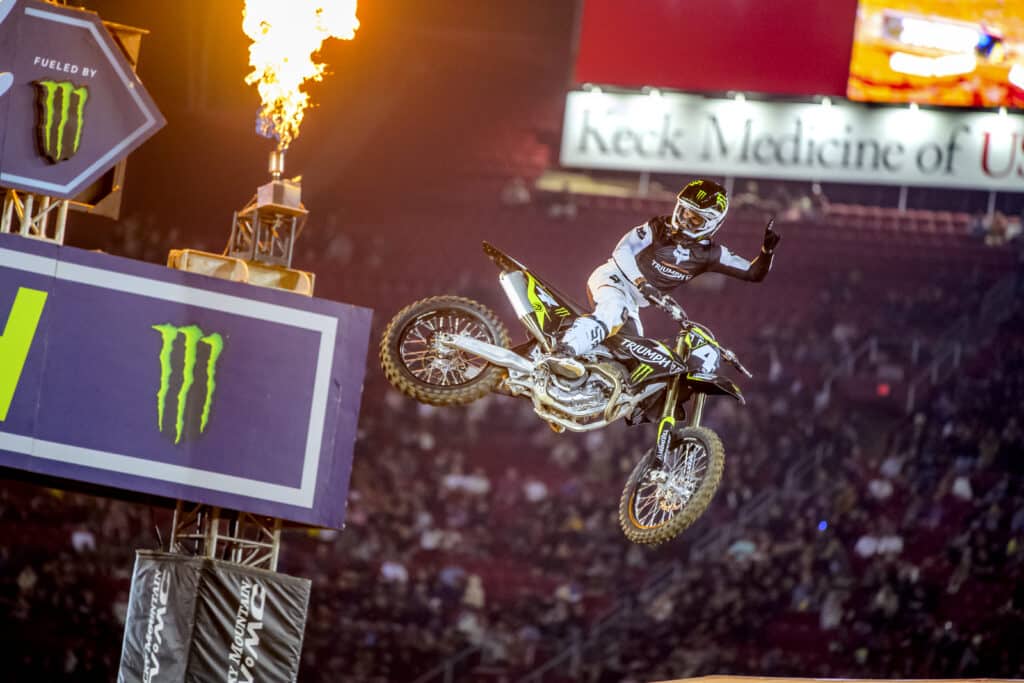
“I think, with the history of that number and the success it has had in SMX throughout the years, and the heritage it comes with, Sexton will be a great ambassador for that number,” Carmichael says. “He will serve it well and continue its legacy.”
Box Van Tee
Blake Baggett Takes The Four
Sixteen racing seasons have started and finished since Carmichael’s last wins. The number four has won just seven races since 2007 but for half of that span, it wasn’t even on the track.
Requests to the American Motorcyclist Association to have the number retired after Carmichael’s career were denied but the AMA kept it out of the number pool for several years. Blake Baggett became single-digit-eligible after he won the 2012 250 Pro Motocross title and he chose number four. Carmichael was inducted into the AMA Motorcycle Hall of Fame in 2013, the same year that his old number went racing again.
When Baggett moved up to the 450 division and switched to Suzuki–a brand that Carmichael worked with at the time–he opened up to Racer X’s Jason Weigandt.
“A lot of people hammered on me about it,” Baggett said in 2014, of choosing the number four. “There’s only so many numbers out there. It’s just a number and I’m just going to represent it the best I can and go out there and try to be known for Blake Baggett as number four.”
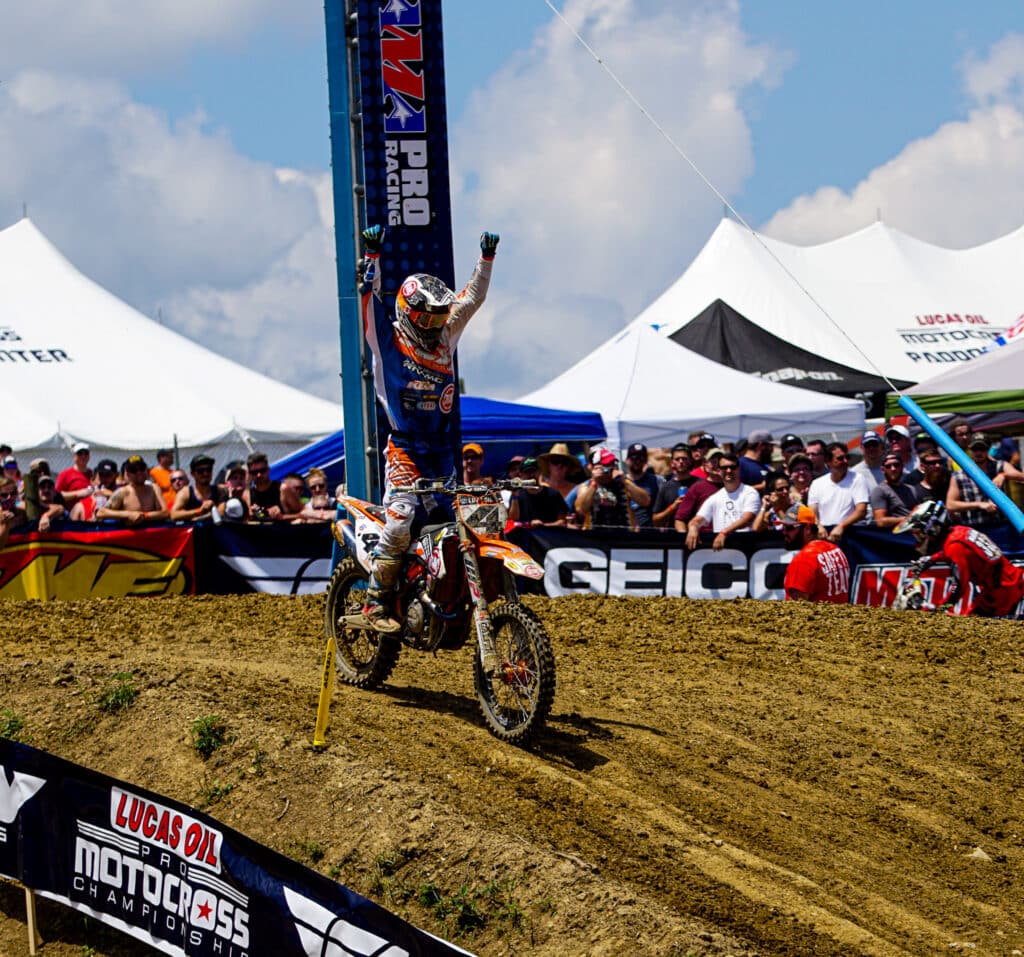
Baggett put the number on top at the 2014 Daytona Supercross, won a handful of Pro Motocross races with it in both classes, a 450SX in 2019 and even held the 450MX red number plate background briefly in 2017. But then he didn’t line up at all in 2021 and it doesn’t seem like he ever will, at least at the professional level. The number went back into the pool after the 2021 season.
Jett Lawrence could have selected a single digit after winning that summer’s 250 Pro Motocross crown, but he stuck with 18. He’s now a three-time Pro Motocross champion, so he had priority following the 2023 regular racing season.
In a pre-race press conference at the SMX finals in Los Angeles, he answered quickly when asked if he had considered a single digit number ‘like four or five,’ given his close association with his riding coach Johnny O’Mara, who wore both numbers in the 1980s.
“It’d be great but, sadly enough, when you see number 4, you think of Ricky Carmichael and then number 5, Ryan Dungey, and I know for sure that [for me and] Hunter, we want to make sure that we have our numbers so when the future comes and we retire, 18 is Jett Lawrence’s number and 96 is Hunter Lawrence’s number,” he said.
The very next night in LA, Baggett brought his son, Braeker to the Los Angeles Memorial Coliseum. Fresh off his fourth birthday, Braeker competed in an intermission STACYC race with a big number four on his jersey.
Just like dad.
A Historical Primer on the Permanent Numbering System
Approximately eight years to the day before his last race, Carmichael chose four as his new riding number. At the end of the 1999 racing season, the AMA implemented a new permanent numbering system, and active past/defending champions Jeremy McGrath, Jeff Emig, Doug Henry, Carmichael, Steve Lamson and Greg Albertyn were allowed to select numbers that they could keep for the rest of their racing careers. Single digits were reserved specifically for champions, but they were not obligated to choose one.
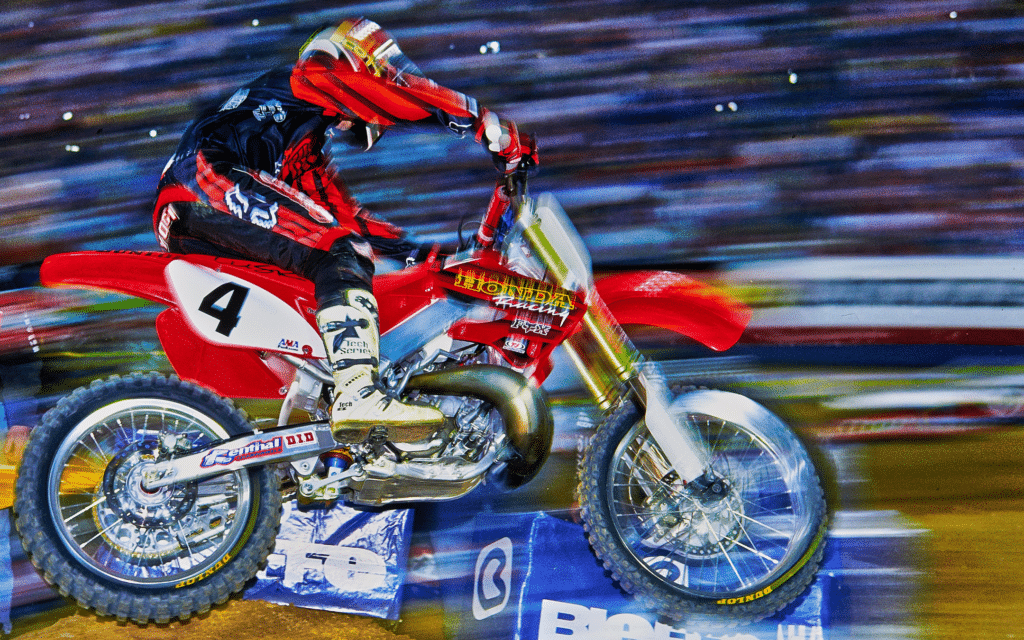
Under the previous system, riders were given numbers based on how many points they scored in the season. Champions defended with the number one plate but in the division where they were not the champion, they ran a number that reflected how they finished if all the points were tallied together from Pro Motocross and Supercross.
In the fall of 1999, McGrath chose two, Emig took three and Henry said he had the option to select four but didn’t. “I was getting ready to retire,” he says in a text message. “I didn’t want to take a single digit into retirement.” Instead, he chose 19 as his permanent number, which he also ran in 1992 and 1998. “I like #19. It represented the beginning and the end of my career.”
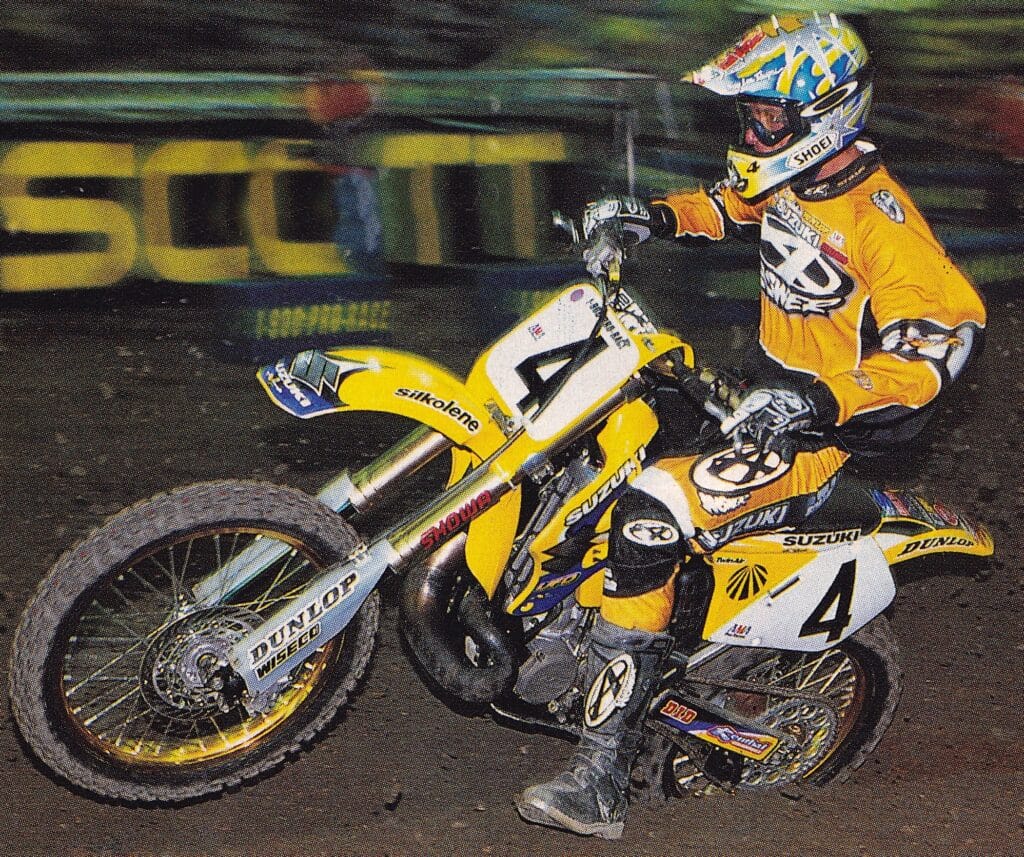
Non-champions who finished in the top 10 in combined points were allowed to pick a two digit number as their permanent identity. That’s how Kevin Windham got 14, Tim Ferry 15, etc.
The Legend of Jimmy Fenton
Carmichael doesn’t remember the 1999 selection pecking order, but he got the only number he had even considered: four. That number had family history. When he showed up at his first amateur motocross race with blank number plates, his dad, Big Rick, said they had to pick something to run. Without hesitation he said, “Four, just like Uncle Jimmy.”
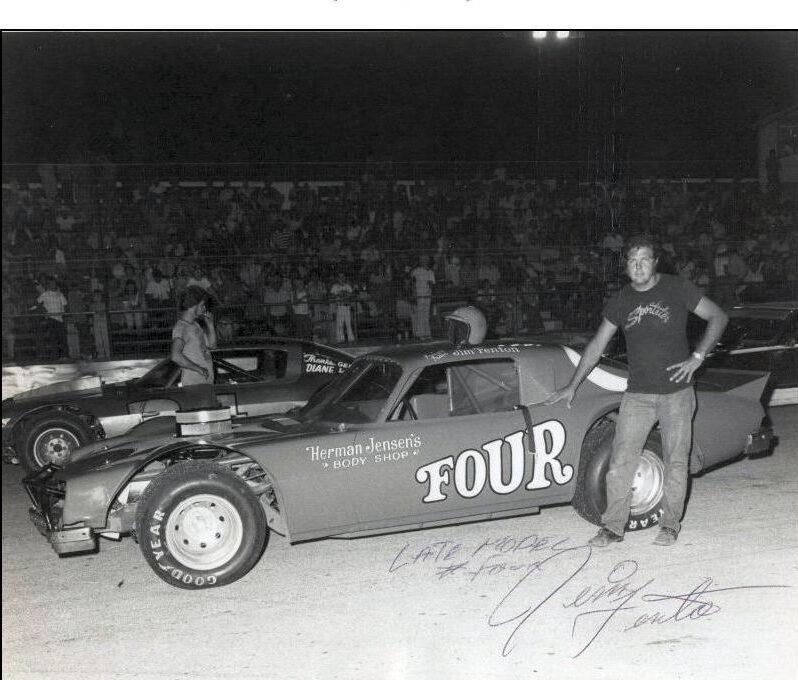
In 1970s Florida, Jimmy Fenton was a short track racer who ran the entire word “FOUR” spelled out on the door of his stock car. Fenton raced late model and super late models and won events at Sunshine Speedway, New Smyrna Raceway and other tracks in the region. On Nov. 4, 1979, he won the Governor’s Cup. Three weeks later, his sister-in-law Jeannie Carmichael welcomed her son, Ricky, into the world.
Carmichael Art!
Fast forward two decades and Ricky made it his goal to take Uncle Jimmy back to the top. When he won the 2000 250/450 Pro Motocross title he kept number four on his Kawasaki for 2001. The new numbering system did not require him to run the number one plate (that rule changed for 2009. Expect a #1 on Sexton’s KTM).
Of the 19 championships won with a number four in motocross history, 12 of them are Carmichael’s He took Uncle Jimmy to the top. And then some.
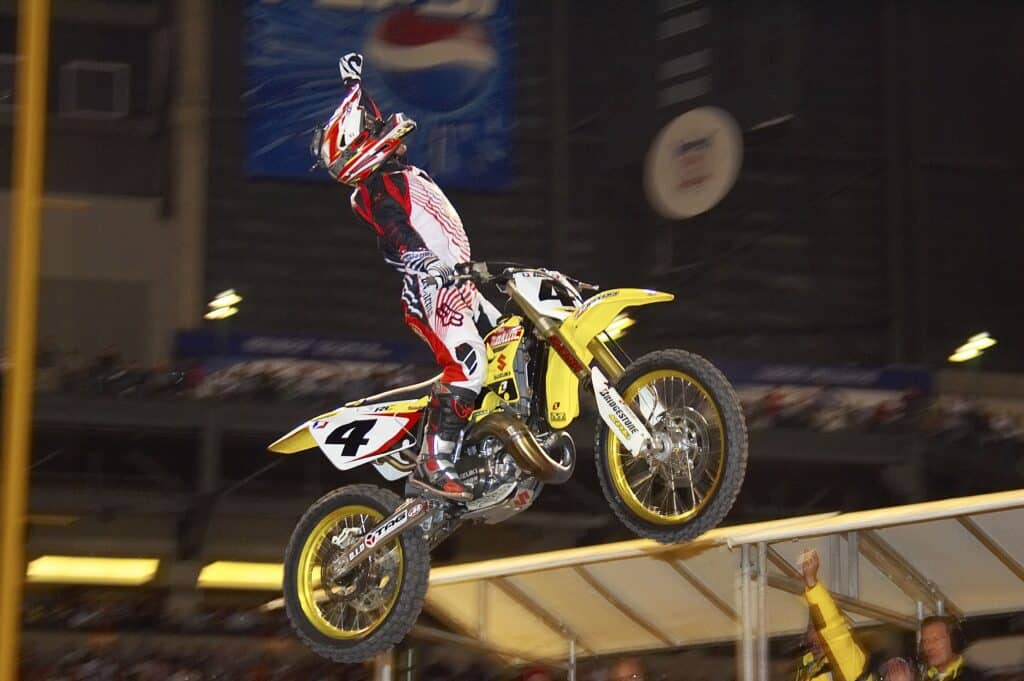
RC only deviated from his commitment to four once in his career; on Sept. 12, 2004, as a gesture to the Honda team personnel, he ran number one on his CRF450R, his final race with the brand.
The Number Four in Motocross History
Going back to 1973, Sexton will be the 25th unique rider to have earned or selected number four in Pro Motocross and Supercross, when John “The Flyin’ Hawaiian” Desoto used it on his CZ through the 1973 Pro Motocross season.
Of all the riders who wore or earned number four, 16 of them are now in the AMA Motorcycle Hall of Fame.
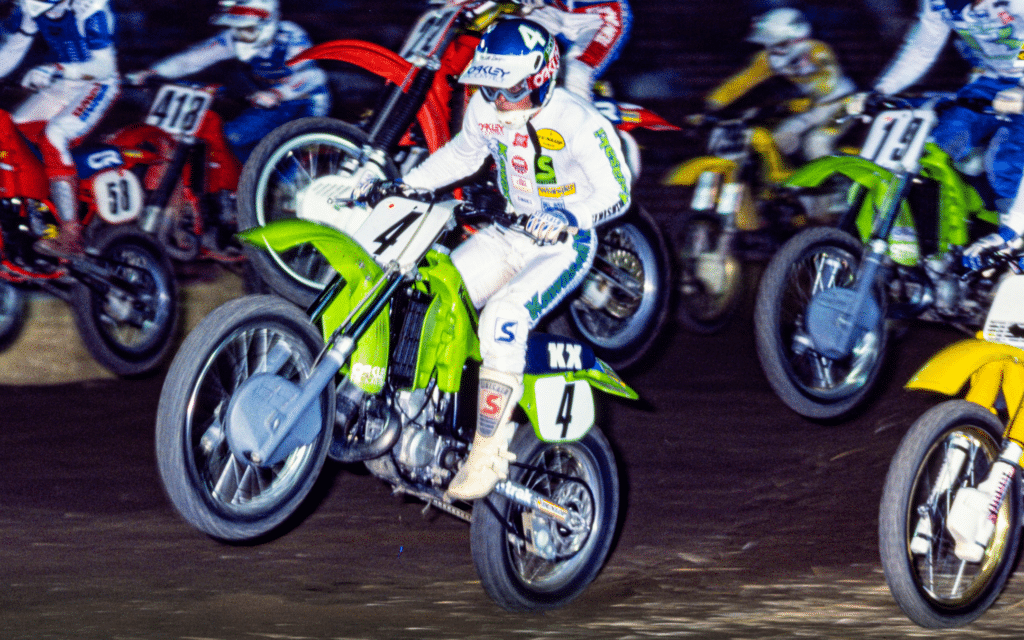
Carmichael and Baggett each ran it for eight years but they’re not the only riders to use it for multiple years. Steve Lamson had it in three different seasons in the 1990s, near the end of the earned number era.
Kent Howerton, Ron Lechien, Johnny O’Mara and Broc Glover each had it for two years. Of the 202 wins by number four, Carmichael’s 125 represents 62% of the share.
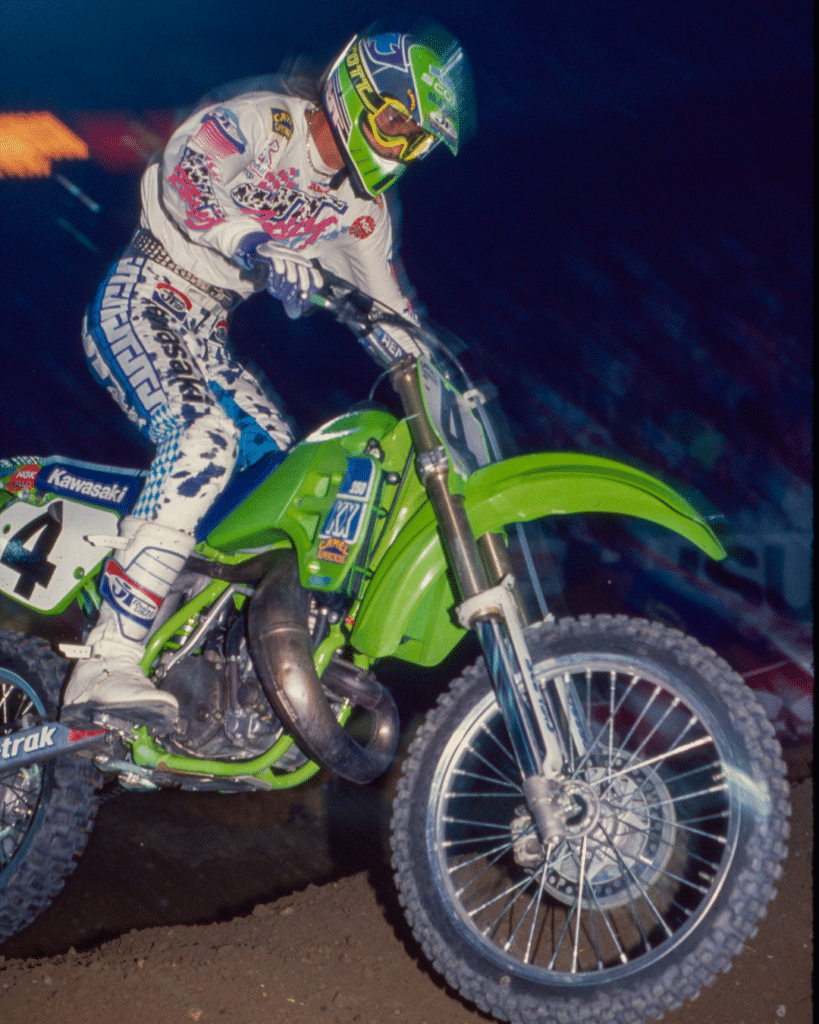
Quirky number four facts
— Had Jean-Michel Bayle raced in America in 1993, he would have been number four.
–Six different brands have won races with four. Honda leads them all with 64 wins from six different riders.
— In 1979, because of a new rule, four different riders were assigned number four, Tommy Croft (500MX), Rick Burgett (250SX), Pierre Karsmakers (250MX) and Steve Wise (125MX).
–Like Bayle, Karsmakers didn’t run four because he didn’t continue racing in the United States. Also, Wise didn’t compete in the 125 class in 1979, so he also didn’t actually run number four.
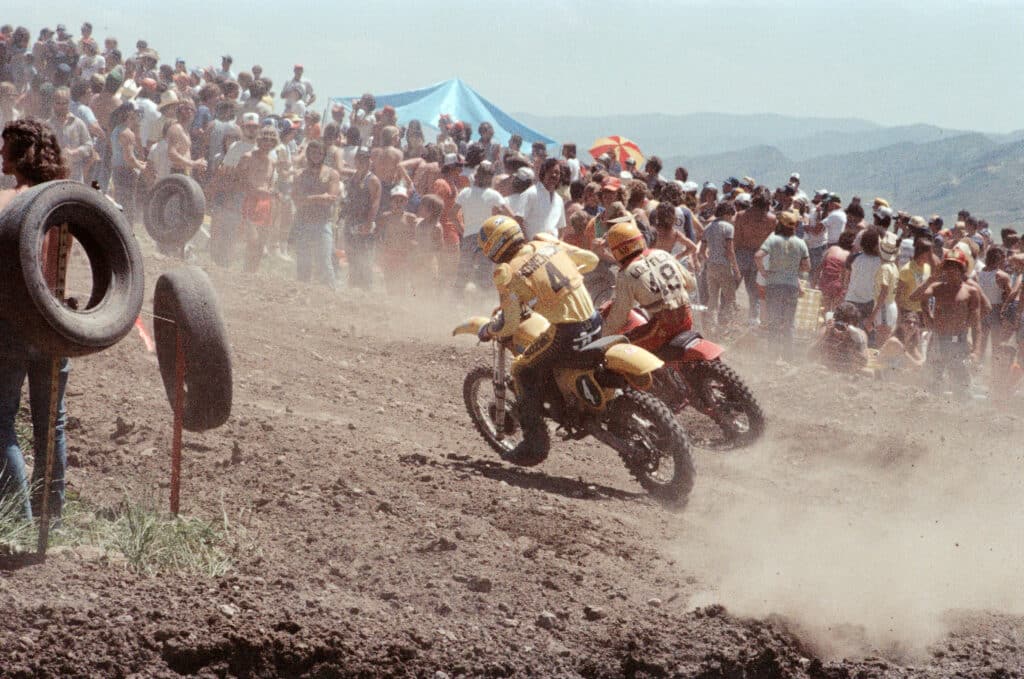
Chase Sexton’s History with Four
Examining Sexton’s number history, a four has been present for the majority of his riding life. He had 486 on his Yamaha PW50 and on his Cobra CX65 in November 2010 when he took that model bike to its first major amateur motocross title. He carried 486 into the summer of 2017 when he raced his first Pro Motocross events.

For 2018 he earned number 40 and took six podium finishes with it. When Aaron Plessinger won the 2018 250MX title and swapped 23 for seven, Sexton picked up the vacated 23 for 2019. Over five seasons he won 20 races with it, (250SX, 450 SX/MX and 450SMX) and three championships.
Fans who loved Sexton’s basketball-themed riding gear can still hope for a Chicago Bulls motif from a generation before Jordan. NBA Hall of Famer Jerry Sloan was born in Illinois, Sexton’s original home state. From 1966-1976 Sloan was so successful as a Bulls shooting guard that the team retired his career number: four.
Chronology of #4
